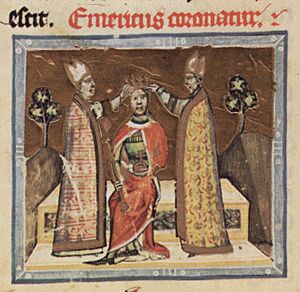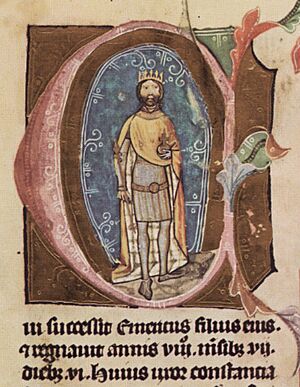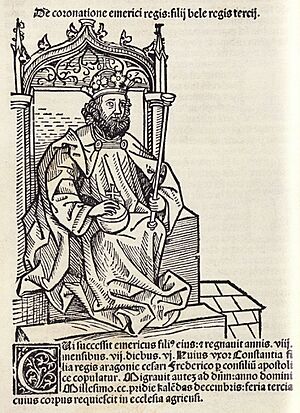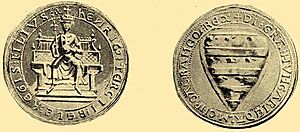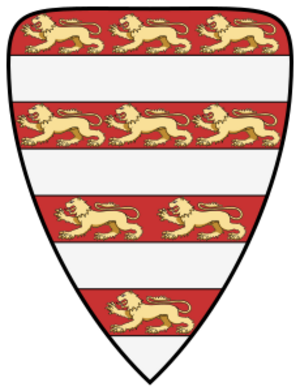Emeric, King of Hungary facts for kids
Quick facts for kids Emeric |
|
|---|---|
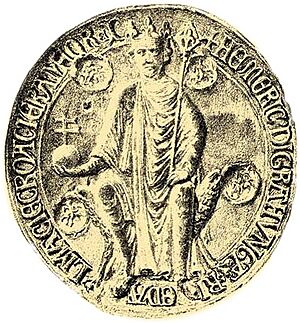
Emeric's royal seal
|
|
| King of Hungary and Croatia | |
| Reign | 23 April 1196 – 30 November 1204 |
| Coronation | 16 May 1182, Esztergom |
| Predecessor | Béla III |
| Successor | Ladislaus III |
| Born | 1174 |
| Died | 30 November 1204 (aged 29–30) |
| Burial | Eger |
| Spouse | Constance of Aragon |
| Issue | Ladislaus III |
| Dynasty | Árpád dynasty |
| Father | Béla III of Hungary |
| Mother | Agnes of Antioch |
| Religion | Roman Catholic |
Emeric (born 1174, died 1204) was a king who ruled both Hungary and Croatia. He was also known as Henry or Imre. His father, Béla III of Hungary, had him crowned king in 1182. This meant Emeric was chosen to take over the throne after his father. Around 1195, his father also made him the ruler of Croatia and Dalmatia.
Emeric became king in 1196 after his father passed away. For the first four years of his rule, he had to deal with his younger brother, Andrew. Andrew wanted more power and fought against Emeric. Eventually, Emeric had to give Andrew control over Croatia and Dalmatia as his own special territory.
King Emeric worked with the Holy See (the Pope and the Catholic Church) to deal with the Bosnian Church. The Catholic Church believed some of their ideas were wrong. Emeric also used a civil war in Serbia to make his kingdom stronger there. However, he couldn't stop the city of Zadar from being captured in 1202. This happened when Venice and crusaders from the Fourth Crusade attacked it. He also couldn't stop the rise of Bulgaria near his kingdom's southern borders.
Emeric was the first Hungarian king to use the "Árpád stripes" as his own symbol. This design later became part of Hungary's coat of arms. He was also the first Hungarian king to use the title "King of Serbia." Before he died, Emeric made sure his young son, Ladislaus III, was crowned king. Ladislaus was only four years old at the time.
Contents
Early Life of King Emeric (1174–1196)
Emeric was the oldest child of Béla III of Hungary and his first wife, Agnes of Antioch. His teacher was an Italian priest named Bernard. When Emeric was eight years old, he was crowned king on May 16, 1182. This important event confirmed that he would be the next ruler after his father.
Emeric was supposed to marry a daughter of the Holy Roman Emperor Frederick I. Sadly, she passed away in 1184. Around 1195, his father, King Béla III, put Emeric in charge of ruling Croatia and Dalmatia.
Emeric's Time as King
Fighting with His Brother (1196–1200)
Emeric became king after his father died on April 23, 1196. His father, Béla III, had left money and lands to Emeric's younger brother, Andrew. This was meant for Andrew to lead a crusade to the Holy Land. However, Andrew decided to challenge Emeric instead. In 1197, he demanded his own separate duchy (a territory ruled by a duke).
Leopold VI, Duke of Austria, helped Andrew. By the end of 1197, their combined armies defeated Emeric's troops. In early 1198, Emeric was forced to make Andrew the Duke of Croatia and Dalmatia. This was a special territory given to a royal family member.
Andrew kept planning against Emeric. Pope Innocent III kept telling Andrew to go on a crusade instead. On March 10, 1199, Emeric made one of Andrew's supporters, Boleslaus, Bishop of Vác, hand over documents. These papers proved Andrew was plotting against the king.
In the summer of 1199, Emeric's army defeated Andrew's army near Lake Balaton. Andrew then fled to Austria. A special messenger from the Pope, named Gregory, came to Hungary. He helped the two brothers make peace. In the summer of 1200, Emeric again gave Croatia and Dalmatia to Andrew as part of their agreement.
Wars in the Balkan Region (1200–1203)
Around the year 1200, King Emeric became very involved in the countries of the Balkan Peninsula. On October 11, 1200, Pope Innocent asked Emeric to take action against people in Bosnia who the Church called "heretics." These were people whose religious beliefs differed from the main Catholic Church.
The Pope refused to send a royal crown to Grand Prince Stephen of Serbia at Emeric's request. Emeric then invaded Serbia in 1201 or 1202. He helped Stephen's brother, Vukan, take over the throne. To show his power over Serbia, Emeric became the first Hungarian king to use the title "King of Serbia" in 1202. He was also the first king to use a royal seal with the "Árpád stripes" design. This design later became a famous part of the coat of arms of Hungary.
In the summer of 1202, the leader of Venice, Enrico Dandolo, made a deal with the leaders of the Fourth Crusade. They agreed to help Venice get back Zadar, a city in Dalmatia. Zadar had been under Hungarian rule since 1186. Even though Pope Innocent III told the crusaders not to attack Zadar, they captured the city on November 24. They then gave it to the Venetians. The Pope punished the Venetians and crusaders for this, but Zadar remained under Venice's control.
Fearing that Emeric might start a crusade against him, Ban Kulin of Bosnia held a meeting of the Bosnian Church. This meeting took place at Bilino Polje on April 6, 1203. At this meeting, the Bosnian Church agreed to follow the Pope's authority and change some of their religious practices. Kulin also recognized Emeric as his ruler. In a letter from 1203, the Bulgarian tsar Kaloyan told Pope Innocent that Emeric had taken five areas in Bulgaria. Kaloyan asked the Pope to step in and help.
Emeric's Final Years (1203–1204)
In the autumn of 1203, Duke Andrew again started an open rebellion against King Emeric. Their armies met at Varaždin, near the river Drava, in October. According to a writer from that time, Emeric walked into his brother's camp without any weapons. He said, "Now I shall see who will dare to raise a hand to shed the blood of the royal lineage!" No one dared to stop the king. He walked up to Andrew and captured him without any fight.
Duke Andrew was held prisoner for several months. However, his supporters managed to free him in early 1204. While Hungary was in a civil war, Kaloyan of Bulgaria attacked and captured Belgrade and other fortresses. Emeric started getting ready for a fight against Bulgaria. But he stopped his army when Pope Innocent asked him to. The Pope was trying to make a deal with Kaloyan. He sent a royal crown to Kaloyan. However, Emeric captured the Pope's messenger who was carrying the crown when he passed through Hungary.
Emeric became very sick. On August 26, 1204, he had his four-year-old son, Ladislaus, crowned king. He also released the Pope's messenger. Emeric made peace with his brother Andrew. He asked Andrew to take care of his young son and manage the kingdom until Ladislaus was old enough to rule. Emeric died on November 30, 1204, and was buried in the cathedral of Eger.
Family Life
Emeric's wife was Constance of Aragon. She was the daughter of King Alfonso II of Aragon. They got married sometime between 1196 and 1200. Their only known child, Ladislaus, was born around 1200. Sadly, Ladislaus died on May 7, 1205. Queen Constance lived longer than both her husband and her son. She later married Frederick II, Holy Roman Emperor.
| Ancestors of Emeric of Hungary | ||||||||||||||||||||||||||||||||||||||||||||||||||||||||||||||||||||||||||||||||||||||||||||||||||||||||||||||||||||||||||||||||||||||||||||||||||||||||||||||||||||||||||||||||||||||||||||||||||||||||||||||||||||||||||||||||||||||||||||||||||||||||||||||||||||||||||||||||||||||||||||||||||||||||||||||||||||||||||||||||||||||||||||||||||||||||||||||||||||||||||||||||||||||||||||||||||||||||||||||||||||||||||||||||||||||||||||||||||||||||||||||||||||||||||||||||||||||||||||||||||||||||||||||||||||||||||||||||||||||||||||||||||||||||||||||||||||||||||||||||||||||||||||||||||||||||||||||||
|---|---|---|---|---|---|---|---|---|---|---|---|---|---|---|---|---|---|---|---|---|---|---|---|---|---|---|---|---|---|---|---|---|---|---|---|---|---|---|---|---|---|---|---|---|---|---|---|---|---|---|---|---|---|---|---|---|---|---|---|---|---|---|---|---|---|---|---|---|---|---|---|---|---|---|---|---|---|---|---|---|---|---|---|---|---|---|---|---|---|---|---|---|---|---|---|---|---|---|---|---|---|---|---|---|---|---|---|---|---|---|---|---|---|---|---|---|---|---|---|---|---|---|---|---|---|---|---|---|---|---|---|---|---|---|---|---|---|---|---|---|---|---|---|---|---|---|---|---|---|---|---|---|---|---|---|---|---|---|---|---|---|---|---|---|---|---|---|---|---|---|---|---|---|---|---|---|---|---|---|---|---|---|---|---|---|---|---|---|---|---|---|---|---|---|---|---|---|---|---|---|---|---|---|---|---|---|---|---|---|---|---|---|---|---|---|---|---|---|---|---|---|---|---|---|---|---|---|---|---|---|---|---|---|---|---|---|---|---|---|---|---|---|---|---|---|---|---|---|---|---|---|---|---|---|---|---|---|---|---|---|---|---|---|---|---|---|---|---|---|---|---|---|---|---|---|---|---|---|---|---|---|---|---|---|---|---|---|---|---|---|---|---|---|---|---|---|---|---|---|---|---|---|---|---|---|---|---|---|---|---|---|---|---|---|---|---|---|---|---|---|---|---|---|---|---|---|---|---|---|---|---|---|---|---|---|---|---|---|---|---|---|---|---|---|---|---|---|---|---|---|---|---|---|---|---|---|---|---|---|---|---|---|---|---|---|---|---|---|---|---|---|---|---|---|---|---|---|---|---|---|---|---|---|---|---|---|---|---|---|---|---|---|---|---|---|---|---|---|---|---|---|---|---|---|---|---|---|---|---|---|---|---|---|---|---|---|---|---|---|---|---|---|---|---|---|---|---|---|---|---|---|---|---|---|---|---|---|---|---|---|---|---|---|---|---|---|---|---|---|---|---|---|---|---|---|---|---|---|---|---|---|---|---|---|---|---|---|---|---|---|---|---|---|---|---|---|---|---|---|---|---|---|---|---|---|---|---|---|---|---|---|---|---|---|---|---|---|---|---|---|---|---|---|---|---|---|---|---|---|---|---|---|---|---|---|---|---|---|---|---|---|---|---|---|---|---|---|---|---|---|---|---|---|---|---|---|---|---|---|---|---|---|---|---|---|---|---|---|---|---|---|---|---|---|---|---|---|---|---|---|---|---|---|---|---|---|---|---|---|---|---|---|---|---|---|---|---|---|---|---|---|---|---|---|---|---|---|---|---|---|---|---|
|
||||||||||||||||||||||||||||||||||||||||||||||||||||||||||||||||||||||||||||||||||||||||||||||||||||||||||||||||||||||||||||||||||||||||||||||||||||||||||||||||||||||||||||||||||||||||||||||||||||||||||||||||||||||||||||||||||||||||||||||||||||||||||||||||||||||||||||||||||||||||||||||||||||||||||||||||||||||||||||||||||||||||||||||||||||||||||||||||||||||||||||||||||||||||||||||||||||||||||||||||||||||||||||||||||||||||||||||||||||||||||||||||||||||||||||||||||||||||||||||||||||||||||||||||||||||||||||||||||||||||||||||||||||||||||||||||||||||||||||||||||||||||||||||||||||||||||||||||


